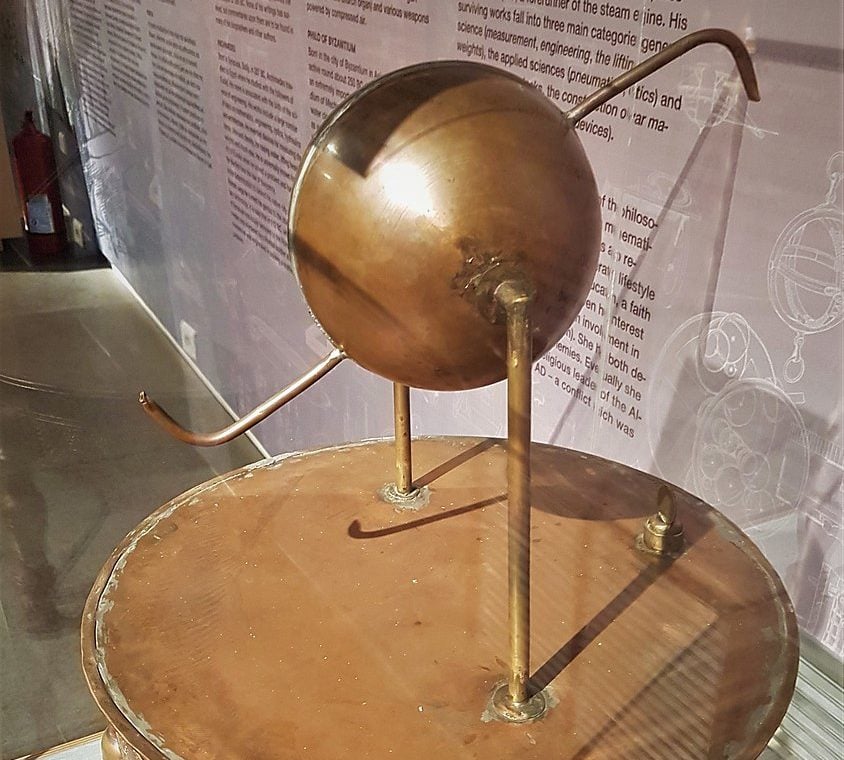
Heron of Alexandria was a brilliant ancient Greek inventor who was ahead of his time and created a prototype of a steam engine.
This unique mechanism was perhaps too modern for its epoch and remained unappreciated. It was mainly used as a toy for display to spectators.
Who Was Heron, the Great Engineer and Inventor of Antiquity?
Heron’s identity remains shrouded in mystery, with scant information available about the details of his life, including the exact years he was alive. However, it is widely believed that he lived in the first century AD and made remarkable discoveries during this time.
Heron of Alexandria, Greece (10-70 BCE) is credited with the first working pneumatic steam engine. He was building on the works of Ctesibius (285–222 BCE) in Alexandria, Egypt, and the Roman, Vitruvius (80 BCE – 15 CE). pic.twitter.com/GrUSE5JTv0
— Tucson Fluid Power (@TucsonFluid) February 17, 2021
Researchers suggest that Heron probably had Greek or Greek-Egyptian roots. While living in Alexandria, he delved into the vast collections of its famous library. It is assumed that Heron was a teacher, given that his contributions to engineering and mathematics included detailed step-by-step explanations similar to educational materials.
Heron went down in history as the creator of many outstanding ideas. Despite the fact that a large number of his works were burned in a fire in the Alexandria Library, some of his amazing inventions have been preserved to this day.
Among these innovations, Heron designed the world’s first holy water vending machine. Visitors inserted a coin into the machine, which activated a lever to open a valve, allowing water to flow out. Additionally, he created an automatic door opener for the temple, utilizing heat and pneumatics to “magically” open the doors.
1/3
History of vendingThe first known vending machine was created as far back as the first century AD by Greek mathematician and inventor Heron of Alexandria. pic.twitter.com/F8k6FOvMIg
— ForYAH (@forYA7747Y) July 10, 2023
However, his most amazing discovery was the steam engine, the potential of which remained forgotten for many centuries.
The Aeolipile
Heron’s most renowned contribution is encapsulated in a pair of books collectively referred to as Pneumatica. These pioneering volumes explore steam and hydraulic power. Heron cleverly uses religious statues and iconography as illustrative models for his mechanical concepts. It was in this work that Heron described the aeolipile, a mechanism that would later change the world.
Translated as the “wind ball,” the aeolipile marked the earliest documented instance of a steam engine or reaction steam turbine.
According to Paul Keyser, an expert on ancient technology, “Heron’s device is a demonstration of the principle of the rocket, that is, of the principle of reactive force: the sphere spins in reaction to the emission of steam.”
The mechanism consisted of a hollow sphere mounted so as to be able to rotate as steam escaped from two outlets located at the equator of the boiler. A sphere half filled with water began to move as soon as a fire was lit under it. The torque was created as a direct result of the steam being generated.
However, the practical use of Heron’s aeolipile remains unknown. Most experts believe it and other inventions from Pneumatica entertained and amazed spectators as toys. Heron’s writings lack explicit explanations of potential uses for the device. Instead, he focuses on providing instructions for its construction and operation.
Experts hold varying opinions regarding the underappreciation of this remarkable invention. One theory attributes it to the societal structure of ancient times. In a society heavily reliant on slave labor, there was little need for mechanisms that could potentially enhance the lives of these slaves. Emperors and rulers saw no incentive in developing machines capable of replacing a readily available labor force.
This pattern persisted throughout Europe for centuries until the advent of the Industrial Revolution, which expanded global demands beyond manual capacity. It was only then that steam engines gained significance and utility.
Revival of Interest of the ancient Greek Steam Engine
For over a millennium, Heron’s inventions remained forgotten. It was during the Renaissance, as the Catholic Church’s hold on science weakened, that Heron’s work resurfaced.
In 1543, scientist and Spanish Navy Captain Blasco de Garay presented Charles the Fifth, the emperor and king, with a device, suggesting it could propel ships without the aid of wind. It is believed that De Garay’s creation, featuring a copper cauldron driving rotating wheels on both sides of the ship, may have been an aeolipile. Subsequently, translations of Heron’s work began to circulate globally.
See all the latest news from Greece and the world at Greekreporter.com. Contact our newsroom to report an update or send your story, photos and videos. Follow GR on Google News and subscribe here to our daily email!



